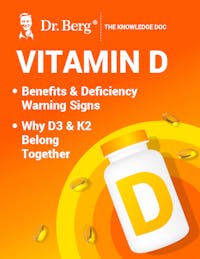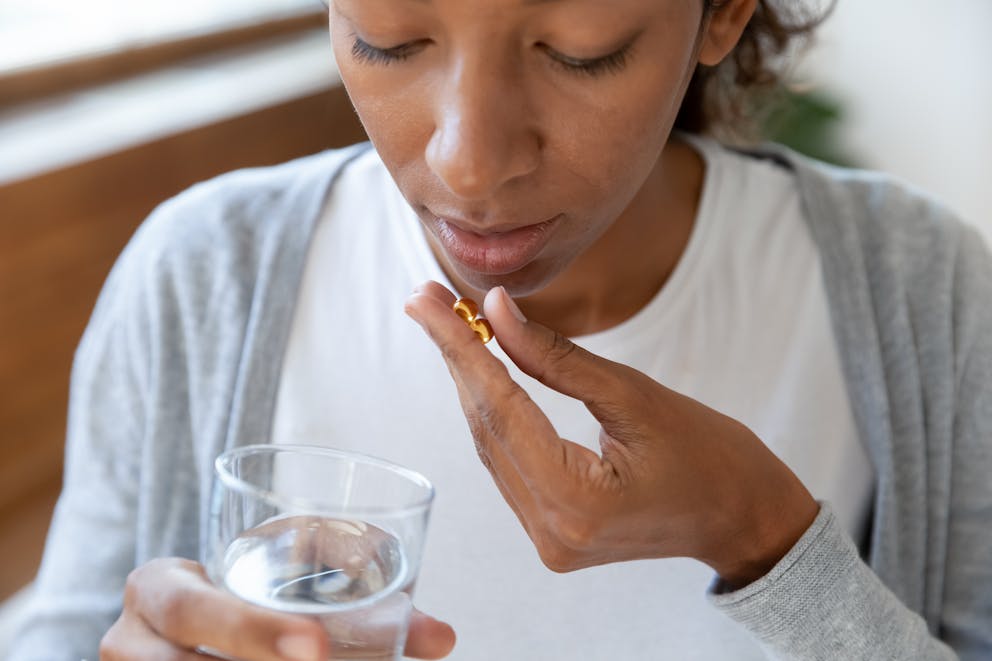Vitamin D Overdose: Can You Take Too Much Vitamin D?

Vitamin D – Benefits and Deficiency Warning Signs
Learn to recognize early signs of vitamin D deficiency
Discover how to maintain healthy vitamin D levels
Explore common factors that can contribute to vitamin D deficiency
Understand why vitamin D3 and K2 should always be taken together
Get practical advice on how to maximize the health benefits of vitamin D

Vitamin D – Benefits and Deficiency Warning Signs
Learn to recognize early signs of vitamin D deficiency
Discover how to maintain healthy vitamin D levels
Explore common factors that can contribute to vitamin D deficiency
Understand why vitamin D3 and K2 should always be taken together
Get practical advice on how to maximize the health benefits of vitamin D

Vitamin D – Benefits and Deficiency Warning Signs
Learn to recognize early signs of vitamin D deficiency
Discover how to maintain healthy vitamin D levels
Explore common factors that can contribute to vitamin D deficiency
Understand why vitamin D3 and K2 should always be taken together
Get practical advice on how to maximize the health benefits of vitamin D

Vitamin D – Benefits and Deficiency Warning Signs
Learn to recognize early signs of vitamin D deficiency
Discover how to maintain healthy vitamin D levels
Explore common factors that can contribute to vitamin D deficiency
Understand why vitamin D3 and K2 should always be taken together
Get practical advice on how to maximize the health benefits of vitamin D

Vitamin D – Benefits and Deficiency Warning Signs
Learn to recognize early signs of vitamin D deficiency
Discover how to maintain healthy vitamin D levels
Explore common factors that can contribute to vitamin D deficiency
Understand why vitamin D3 and K2 should always be taken together
Get practical advice on how to maximize the health benefits of vitamin D

Vitamin D – Benefits and Deficiency Warning Signs
Learn to recognize early signs of vitamin D deficiency
Discover how to maintain healthy vitamin D levels
Explore common factors that can contribute to vitamin D deficiency
Understand why vitamin D3 and K2 should always be taken together
Get practical advice on how to maximize the health benefits of vitamin D

Vitamin D – Benefits and Deficiency Warning Signs
Learn to recognize early signs of vitamin D deficiency
Discover how to maintain healthy vitamin D levels
Explore common factors that can contribute to vitamin D deficiency
Understand why vitamin D3 and K2 should always be taken together
Get practical advice on how to maximize the health benefits of vitamin D

Vitamin D – Benefits and Deficiency Warning Signs
Learn to recognize early signs of vitamin D deficiency
Discover how to maintain healthy vitamin D levels
Explore common factors that can contribute to vitamin D deficiency
Understand why vitamin D3 and K2 should always be taken together
Get practical advice on how to maximize the health benefits of vitamin D

Vitamin D – Benefits and Deficiency Warning Signs
Learn to recognize early signs of vitamin D deficiency
Discover how to maintain healthy vitamin D levels
Explore common factors that can contribute to vitamin D deficiency
Understand why vitamin D3 and K2 should always be taken together
Get practical advice on how to maximize the health benefits of vitamin D

Vitamin D – Benefits and Deficiency Warning Signs
Learn to recognize early signs of vitamin D deficiency
Discover how to maintain healthy vitamin D levels
Explore common factors that can contribute to vitamin D deficiency
Understand why vitamin D3 and K2 should always be taken together
Get practical advice on how to maximize the health benefits of vitamin D
Vitamin D is crucial for a healthy body. It supports strong bones, normal blood calcium levels, and a healthy immune system.
Vitamin D deficiency is widespread, and vitamin D supplementation is an effective and easy way to support healthy vitamin D levels.
Discover how much vitamin D is too much and how you can benefit from vitamin D supplements without the risk of vitamin D toxicity.

Why take vitamin D supplements
Vitamin D is produced in the skin when sun exposure triggers a chemical reaction that converts previtamin D3 to vitamin D3. Vitamin D3 is then transported to the kidneys and liver, where it’s turned into active vitamin D.
The amount of vitamin D your body can produce depends on factors such as sunlight exposure, age, skin tone, body weight, and geographical location.
Small amounts of vitamin D can be found in some foods, including fatty fish, egg yolks, and organ meats. However, dietary sources are unlikely to provide enough vitamin D to maintain healthy blood levels.
Vitamin D is essential for skeletal health—it promotes the intestinal absorption of dietary calcium needed for healthy bones and teeth. It’s also crucial for a strong immune system and has been found to lower the risk of colon, prostate, and skin cancers.
It’s estimated that more than 40 percent of U.S. adults are vitamin D deficient or at risk of vitamin D insufficiency.
Common symptoms of vitamin D deficiency are:
Brittle bones
Weakened immune system
Sleep disorders
Fatigue
Mental health issues, including anxiety and depression
Vitamin D supplements are convenient and effective in supporting healthy vitamin D levels.
Watch the video below to discover how you can maintain healthy vitamin D levels without the risk of toxicity.
Is vitamin D dangerous?
Vitamin D increases the intestinal absorption of dietary calcium, and high doses of vitamin D can lead to elevated serum calcium levels, increasing the risk of kidney damage and soft tissue calcification.
To avoid the risk of excessive calcium absorption, always take vitamin D in combination with vitamin K2.
Vitamin K2 is another fat-soluble vitamin that transports calcium from the blood into bone tissue, which supports healthy bones and lowers the risk of elevated blood calcium and associated health risks.
How much vitamin D3 is too much?
How much vitamin D you need and how much is too much depends on a range of factors, including your actual vitamin D status, age, average exposure to sunlight, and geographical location.
The National Institute of Health recommends 600 international units (IU) of vitamin D daily. However, a significantly higher dosage may be needed if you are vitamin D deficient or have little sunlight exposure.
Doses of up to 10,000 IU daily may be necessary to correct vitamin D deficiency, and evidence suggests that taking 10,000 IU of vitamin D daily wasn’t linked to an increased risk of elevated calcium levels or kidney damage.
Regularly checking serum vitamin D levels is the most reliable way to determine vitamin D requirements and ensure healthy vitamin D levels without the risk of toxicity.

How do you know if you’ve had too much vitamin D?
Vitamin D toxicity is very rare and only related to extreme amounts of vitamin D supplements over long periods of time. Vitamin D metabolism is a tightly controlled process, and there isn’t any risk of an overdose due to sun exposure or from dietary sources of vitamin D.
Because of vitamin D’s role in calcium absorption, taking large doses of vitamin D supplements without vitamin K2 can lead to elevated blood calcium levels, also known as hypercalcemia. While calcium is essential for many physiological functions, hypercalcemia can have serious consequences.
This is why it's essential to take vitamin K2 with vitamin D. Vitamin helps you maintain healthy blood calcium levels.
Research suggests that prolonged periods of excessive blood calcium levels can cause kidney damage and gastrointestinal issues and interfere with normal heart functioning. Severe cases of hypercalcemia have been found to increase the risk of kidney failure and pancreatic cancer.
Symptoms of vitamin D toxicity include:
Vomiting
Weakness
Fatigue
Stomach pains
Frequent urination
Heart arrhythmia
Confusion
Depression
What to do if you take too much vitamin D
If you suspect you may have taken too much vitamin D, it’s best to consult your doctor. A blood test to assess vitamin D status and calcium levels is generally the first step in determining if vitamin D toxicity is present.
Limiting sunlight exposure, restricting dietary calcium intake, and avoiding nutritional supplements containing vitamin D are typical recommendations to correct vitamin D toxicity. In more severe cases, intravenous medication may be necessary to reduce elevated blood calcium levels and protect organs and tissues from calcification.
A number of follow-up blood tests may be necessary to ascertain if vitamin D levels are back in a normal range.

Key takeaways
Vitamin D supplementation is a great way to support healthy vitamin D levels. However, taking vitamin D without vitamin K2 can lead to hypercalcemia, which significantly increases the risk of kidney damage and calcification of blood vessels and may interfere with normal heart and brain function.
It’s recommended to always combine vitamin D with vitamin K2 supplementation to maintain healthy calcium levels. In addition, regular blood checks help to determine the correct vitamin D dose for you and lower the risk of a potential vitamin D overdose and toxicity.
FAQ
1. How much vitamin D can I safely have each day?
The most suitable daily dose of vitamin D for you depends on many factors, including your vitamin D status, sunlight exposure, skin tone, and geographical location. General recommendations suggest a recommended dietary allowance (RDA) of 600 IU of vitamin D.
However, significantly higher dosages can be taken. Research shows that daily intake of up to 10,000 IU of vitamin D doesn't cause toxicity.
2. Can you overdose on vitamin D?
Extremely large doses of vitamin D supplementation over long periods of time may result in a vitamin D overdose and toxicity. However, this is very rare.
3. What are the symptoms of a vitamin D overdose?
Vitamin D supplementation without vitamin K2 can cause elevated levels of blood calcium which is linked to gastrointestinal issues, nausea, excessive thirst, confusion, and fatigue. Excessive calcium levels may interfere with normal brain and heart function and increase the risk of kidney damage and the calcification of blood vessels.
4. What is vitamin D toxicity?
Vitamin D toxicity, also referred to as hypervitaminosis D, results from taking extremely high doses of vitamin D for a prolonged period. Vitamin D toxicity is very rare and doesn't not occur from dietary intake or sun exposure.
5. Is 10,000 IU of vitamin D too much?
Taking 10,000 IU of vitamin D daily is generally considered safe. Regularly check your vitamin D status to ensure that vitamin D levels are in healthy ranges.
Previous blog
Does Dr Berg Still See ClientsNext blog
Health Benefits of HazelnutsTags

Popular
08/21/2024
53.6K views
02/23/2025
45.4K views
11/18/2024
270.1K views
03/18/2024
11/21/2022




